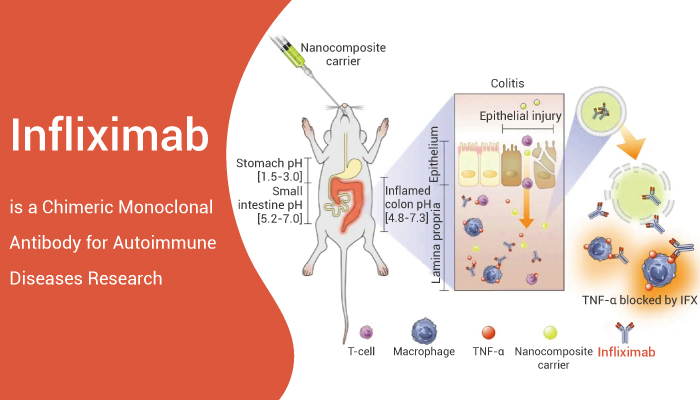Tumor necrosis factor alpha (TNF-α) was initially recognized as a factor that causes the necrosis of tumors. But TNF-α has been identified to have additional important functions as a pathological component of autoimmune diseases. According to studying datas, TNF-α binds to two different receptors, which initiate signal transduction pathways. Moreover, These pathways lead to various cellular responses, including cell survival, differentiation, and proliferation. However, the inappropriate or excessive activation of TNF-α signaling is associated with chronic inflammation and can eventually lead to the development of pathological complications such as autoimmune diseases. Hence, we will introduce Infliximab (Avakine) , a chimeric monoclonal IgG1 antibody that specifically binds to TNF-α.
Infliximab is a chimeric monoclonal antibody that prevents the interaction of TNF-α with TNF-α receptor (TNFR1 and TNFR2).
In vitro, after stimulation of mTNF for 6 hours with Infliximab (1 µg/mL) induced E-selectin expression in Jurkat cells. In addition, Infliximab (10 µg/mL; 24 h) almost completely abolished the proliferation of WT mTNF-transfected Jurkat cells. Moreover, Infliximab (10 µg/mL; 24 h) dramatically induced the apoptosis of mTNF-transfected Jurkat cells. Infliximab not only induces interleukin-10 production, apoptosis, but also G0/G1 cell cycle arrest. Infliximab (10 µg/mL; 24 h) resulted in an increase in proportion of G1 cells to 69.6% and a decrease in the proportion of S cells to 24.7%.
Moreover, a single injection of Infliximab (10 μg/g in 100 μl saline/dose ip) in diabetic TNF-α+/+ mice leads to suppression of the increased serum TNF-α and amelioration of the electrophysiological and biochemical deficits for at least 4 weeks. In other words, Infliximab attenuated the increased TNF-α mRNA expression in diabetic dorsal root ganglion.
In a word, Infliximab is a promising chimeric monoclonal IgG1 antibody for autoimmune diseases research and diabetic.
Reference:
[1] Jang DI, et al. Int J Mol Sci. 2021 Mar 8;22(5):2719.
[2] Mitoma H, et al. Gastroenterology. 2005 Feb;128(2):376-92.
[3] Yamakawa I, et al. Am J Physiol Endocrinol Metab. 2011 Nov;301(5):E844-52.
